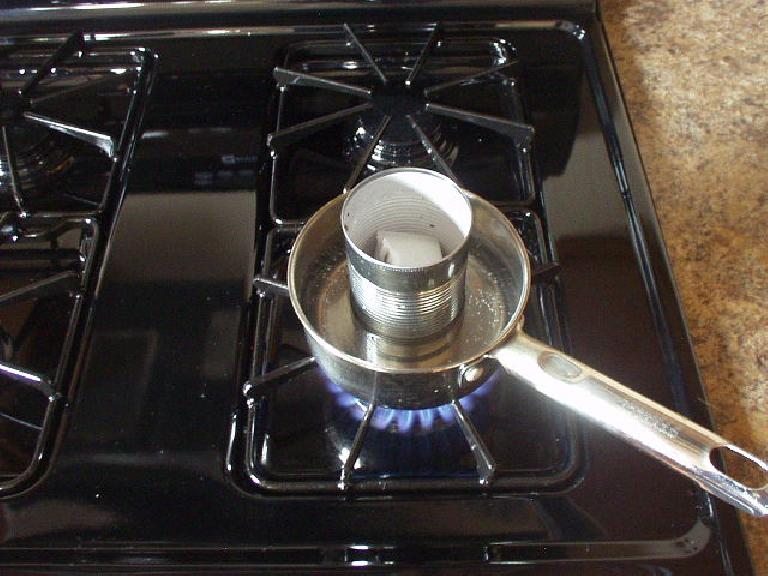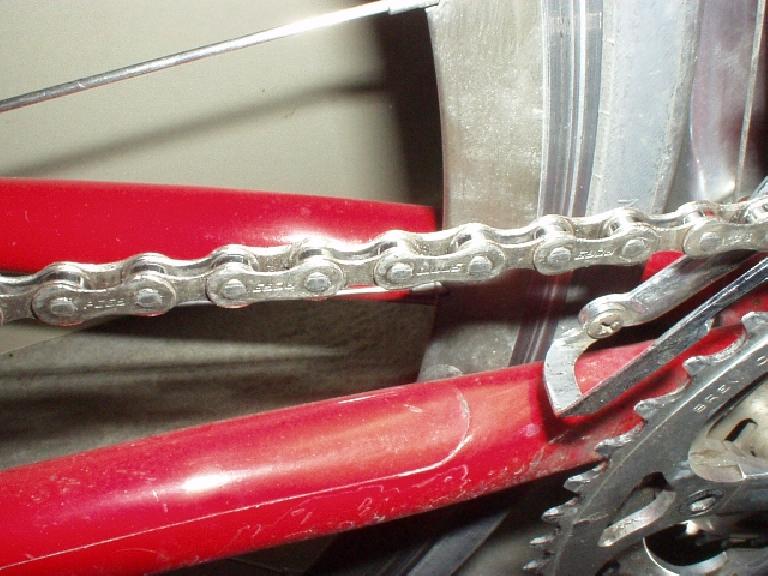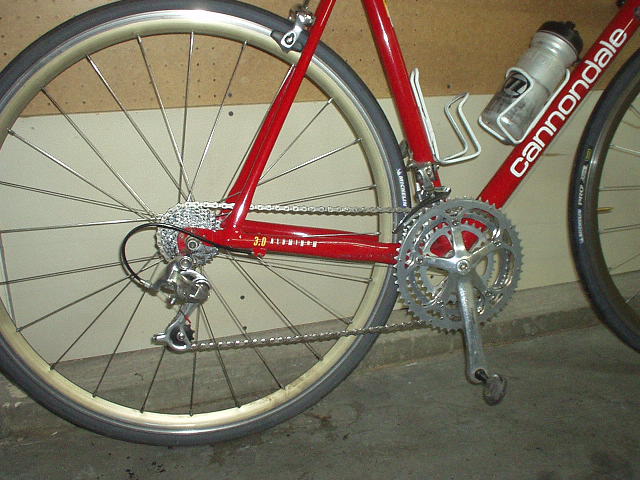Waxed Bicycle Chains
It turns out that hot wax is not only useful for removing unshaven hairs from leggy females, cyclists and triathletes (at least those not named Felix). Apparently, it is good for lubicating bicycle chains as well.
Back in late April, while doing some basic bike maintenance and fingers covered with black, grimy grease, I decided to do an experiment. While I’ve been relatively happy with the Pro-Link bicycle chain lube I’ve been using for years, I wanted to see how the traditional “chain lubed with melted paraffin” method measured up. The claimed advantages of this method was that the chain stays much cleaner and in dry conditions stays lubricated and quieter for longer. The supposed disadvantages include poor lubrication in the rain and requiring a more elaborate setup for lubing the chain.
These are the basic steps I followed:
- Remove the chain from the bike. Clearly, having a master link (e.g., Sachs) that one can quickly undo without a chain tool is convenient for this.
- Buy some paraffin (candle wax). Supposedly, one can find large, inexpensive containers of “canning wax” in a grocery store, but I couldn’t. Therefore, I bought a large white candle from Albertson’s for $1.
- Find a pot and tin can. For the latter, I opened a can of beans. I had black bean burritos for dinner that night.
- Fill the pot up with water and bring to a boil.
- While the water is heating, break up the candle (e.g., using a hammer and screwdriver or chisel). Put the candle bits in the tin can, and put the tin can in the pot of boiling water.

Melting wax inside a tin can inside a pot of boiling water. - While the wax is melting, clean the chain thoroughly with degreaser and a brush. Swishing the chain around in container filled with degreaser and water also works, but in my experience, to get a chain really clean, one is going to have to bust out a brush at some point afterwards. A large stiff-bristled automotive tire brush is much more efficient for cleaning than a small toothbrush, since you can scrub multiple links at a time.
- By the time you have finished cleaning the chain, the wax in the double-boiler setup should be melted. Drop the chain into the melted wax.

Melted wax and a bicycle chain inside a tin can inside a pot of boiling water. - Turn down the heat on the stove; the wax should stay melted even if the water is no longer boiling. Let the chain soak in the melted wax until no more bubbles are emitted from the chain links. (The bubbles are pockets of air in the chain links being displaced by the hot wax.) Ideally, you would be doing something else (like eating dinner, or reading email) during that time, as it could take 15-30 minutes.
- After the thorough soaking, fish out the chain with a spoke end, flat screwdriver, or needle-nose pliers. Then do a quick wipedown of the chain with a rag (careful—the wax is still hot), and hang up the chain to dry.
While this may seem like a fairly lengthy procedure, it really is not more difficult than taking off a chain to clean it and then dripping lubricant on it. In fact, probably the most “difficult” part (aside from the chain cleaning) is opening a tin can, emptying out its contents, breaking up the candle and putting the candle bits in the can. Note that this is only required the first time as you can save the can and wax and reuse it later.
More importantly, you will (almost) never need to clean the chain again! Check out how clean the chain was after three months/287 miles—which is when the chain started to become squeaky enough to warrant rewaxing it.

In fact, the chain was so clean that I could grab the chain and have no black spots on my hands afterwards. So during rewaxing, I did not need to scrub the chain (i.e., skipped Step #6 above entirely) and merely dipped it into the can of melted hot wax.
Another benefit is that the rest of the drivetrain—chainrings, cassette cogs, and rear derailleur pulleys—also stays super clean, reducing maintenance time.
In contrast, no chain lube—be it Pro-Link, Pedro’s Ice Wax, or White Lightning (probably the three cleanest drip-lubes on the market)—could ever keep the chain and drivetrain so grime-free. Also, those lubricants never lasted as long (maybe 200-250 miles for Pro-Link, but only 40-100 miles for the Ice Wax or White Lightning).
It still remains to be seen, however, how well the waxed chain performs in wet conditions. Here in Northern Colorado it hardly ever rains, so I have yet to try it out for more than 10 minutes in the wet. How quiet the chain remains in freezing (winter) weather also remains to be seen. I hear that the hot wax method using paraffin with a little bit of motor oil works well in those conditions. Worst case scenario is that for the extreme-weather months I switch back over to Pro-Link. I will report back later on this during the winter.
Amendment 2006-12-24
I’ve been riding quite a bit in frigid conditions lately on wet roads (due to melted snow/ice), and the waxed chain is still quiet and smooth. Still haven’t had a chance to test the setup in a downpour as it hasn’t rained out here in many months. In any case, I haven’t had to do any chain maintenance or rewaxing since I originally wrote this article 4 months ago and am still very happy with this method.
Reflections 2024-05-21
It’s amazing to think I wrote this post a whopping 18 years ago. While waxing chains was a relatively “fringe” concept back then, it is now mainstream today, with even professional cycling teams waxing chains for the superior friction benefits over lubed chains.
The wax immersion method is still my preferred way of keeping the chain quiet and clean, which is why I’ve stuck with it during all this time.

There are 25 comments.
Hi Felix, any updates on the chain wax preformance in wetter/grimier conditions yet?
Sorry, not yet. The "problem" is it hardly ever rains out here, and if it does (usually only on some summer evenings) the rain lasts for only 30 seconds to one hour. And when it is snowy, I don't ride! :)
But hopefully sometime this winter I will go riding while it is super frigid or snowy and have something to report. Stay tuned...
[...] Originally Posted by Beeping-Sleauty for the last twenty years i have used candlewax It seems others have tried cycle chain lubrication with candle wax also felixwong.com ? Waxed Bicycle Chains Even though you seem happy with the results, I cant help wondering how much more effective a proprietary hot melt chain lube would be, given that it's especially designed for lubricating rather than burning and it's also got a relatively non-tacky surface. [...]
If you can still find a specialized hot melt wax for bike chains, please post the supplier here. I searched extensively, and could no longer find anyone carrying one for sale. Thanks to Felix, for appraising the suitability of plain old candle wax. Canning wax is easily available in my home town. An alternate source would be a hobby or craft shop (Jo-Ann or Michael's), if they carry materials for candlemaking. A four pound block will set you back only about $14.
I had also heard about lubing chains with wax. I was told to mix about a handful of vaseline with the wax. With a bar, meant for canning, the ratio ended up being about 1 to 1 wax to vaseline.
First, I removed the chain and soaked it in an orange degreaser. I brushed the chain some, but it came rather clean from soaking in the degreaser (two rinses).
I then melted the paraffin and vaseline in a double boiler using an old pie tin for the wax and vaseline. I plan on leaving it in the tin. Hopefully, the vaseline will make the lube more water repellent. I am sure the downside of too much vaseline would be a chain that would attract dirt. I may have put too much vaseline. I will adjust this ratio if necessary.
Haven't had an opportunity to try it out yet.
I have been a bike commuter for 35 years. I have always waxed my chain. As far as I am concerned, its the only way to go.
As the writer of the above comment taken from the Pedelecs forum, the proprietary hot melt chain lubricant I've bought is called Putoline Chain Wax and here's a link to it: http://www.putoline.com/en/product_detail.asp?nav=chain&cat=3&prod=road&prodId=2&catalogId=103 - primarily for motorcycle chains but as my bicycle is power assisted (with up to 240 Watts of electric motor assistance) I feel the best lubrication is important under higher than 'normal' loads for a bicycle chain. I tried posting this earlier but was halted by the hard to read letters in the anti-spambot system used - good to see thats changed, thanks.
Have been using the hot wax method for over a quarter million bicycling miles since 1975. Easy to do and wax can be re-used several times.
Some folks have added a bit of graphite to the wax, others motor oil or even vaseline.
But canning wax is cheap/clean/efficient . . . it works!
Pedal on TWOgether!
Rudy and Kay/zonatandem
I have waxed many chains. It is the best way of protecting and lubing a chain. It also is a very cheap product since the components are so cheap. My personal "devil's" mix is 1 part of paraffin + 1 part of oil + a teaspoon of graphite. The oil can be a multigrade motor oil or even olive oil. Adding oil makes the mixture less britlle without becoming sticky. The chain is dry and does not attrackt any grit. The graphite provides an extra way of "dry" lubrification that stays inside the chain's rollers no matter the weather conditions.
Waxed a chain for the first time while at a mountain biking campsite in Utah. No lube, but I had emergency candles and a can from the baked beans which were also cooked over the fire. Necessity the mother of invention there. Now I use the technique to get rid of all those godawful and sometimes stinky candles people give you for Christmas. I don't go through wax very fast, though. I've got stock to last me till 2050.
Vanilla can be quite fast.
Hey guys, great discussion here! Anyone know of an equally easy way to clean gears?
I rode my bike from Los Angeles to Kansas on a paraffin waxed chain and never needed to lube it but just for precaution sake dusted it occasionally with graphite. That's twelve hundred miles and the chain was running great. If you are adding petroleum products to the mix like petroleum jelly and special oils because you can't believe simple paraffin is enough you are missing the point. Adding oily lubricants attracts dirt and grime. Believe either him or your own eyes he says this is an excellent lube. Once you have done it you won't be wondering how much better some "proprietary special formula wax lube" will work. Because how much better do you need it to work than how well it already does? Are you actually looking at the pictures of his chain after three hundred miles? Just do it and stop trying to improve it until you have done it.
I've used wax for years. Its easiest to do with an old pot on the gas grill. I clean the chain with kerosene and a tooth brush then cover with dish soap and rinse. If you dry overnight you can eliminate the "bubbles" when you dip it in the wax. In Western PA if you don't ride in bad weather you won't ride much so the only problem you have in the rain is if you go too long between dips. 300 miles to be safe. It's still quiet and smooth but not totally covered. I rotate 4 chains between 2 bikes. The clean and quiet is worth the effort.
A cheap crockpot works great to keep the wax hot and available, only a $15. The quick link on a Wipperman chain works great for the quick release. Normal paraffin "canning" wax is easy to find.
I've been waxing my road bike chains (I alternate two) for many years. My two current chains have a total of 21,000 miles on them and I'm still using the same cassette, chains and chain rings. I use paraffin and add a little graphite (comes in small tubes) to the melted paraffin. I've been using the same pot for many years and simply add more paraffin & graphite when it gets low. I change chains every 500 miles or when it rains and the drive train get real wet.
A REALLY easy way to clean chains, cassettes, or any other part of the drive train is gasoline. My grandpa has been waxing chains for many many years and he always cleans the chains with gasoline. He has a 5 gallon jug of gas, and has some old pans that he'll pour enough gas into to just barely over the chain. He spins the chain around in the gasoline, and the gasoline turns black with grease and dirt. He'll pour the dirty gas into a second pan, and pour clean gas into the first pan, and repeat the process as needed to clean the chain. What he will do once he's done cleaning things is he'll pour the old dirty gas back into the jug. All of the sediment will sink to the bottom. He's been using the same gasoline for probably 5+ years and it cleans better than any degreaser I've ever used - and I washed bikes at my bike shop for a living.
? could this also work for Mountain bikes? Anyone tried this?
I wax my mountain bike chain also. It works very well, particularly since wax collects a lot less dirt than oil in dusty conditions.
This was a very helpful post for me. Thank you for describing the process so clearly. I found a pound of canning wax at Albertsons for $4.50 called "Parowax." A little over half the box seemed to be enough to coat my chain in the melted wax.
Use an appropriate surfboard wax - most of these are a mix of waxes to ensure suitable performance. Hot weather wax is the hardest mix.
I had been using the hot wax treatment successfully for years, most notably on a cycle tour from Tacoma to Tucson. The first half of the trip was relatively dry and warm, while the second half exposed the chain to all weather conditions: rain, slush and snow storms (I even crossed paths with a group of skiers once). 3600 miles on the road without a relube, and the chain was dry, with only light surface corrosion of the side plates. Subsequent cleaning and dipping got me another year of use out of that chain.
Chain wax is difficult to find from commercial sources, so I'll switch to canning paraffin when I run out of my current supplies. For cold conditions, instead of adding motor oil, I'll give mineral oil (liquid paraffin) a try.
Thanks for stopping by my website and for your comment. Great job on your cycle tour. 3600 miles on a single chain waxing is amazing especially since you rode through some adverse weather conditions. That is great testament to the efficacy of the hot wax treatment!
This was a really helpful guide!
I was looking for a way to reduce the annoying noise coming from the chain on my electric scooter. This has helped to make it significantly quieter.
That is fantastic you were able to use the hot wax chain method for your electric scooter! Thanks for letting me know!
I did my first 'waxed' ride yesterday on my road bike. I used 90% wax, 10% beeswax and a couple of teaspoons of graphite powder. I only did 18 miles but it was super smooth and quiet. One thing I found slightly odd was that you can now hear the chain engaging the front chain ring as you ride but I'll get used to it I guess. It's raining today so I might take it out for a longer test and see how I get on.